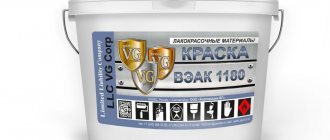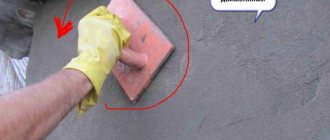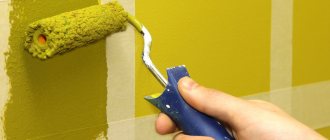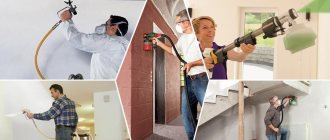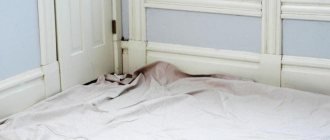The thickness of the layer of household paints is measured in microns and ranges on average from 70 to 150 microns (two layers)
For ease of use, almost any household paint can be diluted. Aqueous - with water, alkyd - with white spirit, nitro - with a solvent. The degree of dilution is on average 5-15% (read the manufacturer's instructions)
The average consumption of household paint is 100 – 150 g per m² when applying one layer (painting is done in 2 layers)
How to optimally distribute the paint layer during application
How to determine visually which layer of paint to apply from practice is very simple. When applying a paint coating with a roller, brush, or spray gun, three main indicators must be taken into account - uniformity of the layer, maximum coverage (try not to let the bottom layer show through) and absence of drips. All these indicators are determined only empirically.
How to paint correctly
If you are painting for the first time, take a test piece of drywall, hardboard, plywood, etc., to practice and, as they say, “get your hands on it.” Or start painting from a small, inconspicuous area of the surface. It is important to consider that the surface to be painted is painted immediately from start to finish without interruption, in order to ensure maximum uniformity of the paint layer and, accordingly, the absence of visible transitions. Those. if these are walls in a room, choose the most inconspicuous small wall and paint from corner to corner.
If painting is done with a roller or brush, try to put the same amount of paint on the tool and remember approximately how much area you have enough of it for the optimal layer. When painting with a spray gun, monitor the speed of your hand and the distance of the gun to the surface to be painted. As a rule, if you adhere to the above rules, after painting the first wall, the subsequent ones will turn out better and better.
How many layers to make
In most cases, you need to paint twice. This ensures uniformity of the paint layer and maximum quality of the paintwork. The first, base layer has a higher consumption, on average 10%
Spacing between coats of paint
The second coat of paint should be applied to a completely dry surface. Drying times for repair paints vary, but there are averages. Water-based paints - 2-8 hours, alkyd - 24 hours, nitro 0.5-3 hours.
Before you start painting, don't forget about the primer. The primer ensures better adhesion of paint to the surface being painted, reduces consumption, ensures uniform absorption, and, accordingly, uniformity of the paint layer. Each paint uses its own primer.
From this article you will learn:
- What types of paints for interior walls are most popular today?
- What are the most common mistakes when painting walls?
- Why painting walls should be at least 2 layers
- How much will it cost to paint walls in several layers?
Today, people are increasingly choosing to paint their walls. And this finishing method is gaining more and more popularity not because it is considered cheaper. Painting walls in 2 layers will cost almost the same price as covering them with high-quality wallpaper. But if wallpaper gives the walls a uniform texture and color, then when painting there are no limiting factors for your imagination. You can come up with your own design or apply a pattern. You won’t need any special skills, but knowing certain rules when working with paints won’t hurt.
How to dilute paint correctly
For breeding, a set of tools available to everyone is used:
- a clean container for diluting the solution (a special painting tray, an old bucket or container from already used building materials);
- drill with mixer attachment.
Correct breeding occurs according to the following algorithm:
- It is necessary to pour the paint into the container, stirring as you go.
- Assess the volume of material in the container and prepare the water. It is added gradually, after each addition the solution is stirred with a drill, then its viscosity is determined.
- If lumps are visible in the solution, homogeneity has not been achieved, you need to continue stirring.
When the paint has reached optimal viscosity, you need to test it on a small area of the surface. If the composition meets all the parameters, lays down smoothly, and does not leave streaks, you can begin painting.
Apply the first coat of paint
Before starting work, you should close the doors and windows to eliminate drafts and maintain humidity - this will allow the paint to dry more slowly and evenly. Additionally, you can spray water with a spray bottle, and also cover the windows with film to protect them from direct sunlight.
If the paint is thick, then for the first layer it can be diluted according to the instructions on the can - usually add 5-10% clean water to the total volume. To avoid streaks, do not skimp and put enough paint on the roller.
Cut the pile at the edges of the roller at an angle of 45°, and the joints of adjacent strips will not be so noticeable.
Start coloring from the corner. Using a roller extension, roll continuous strips from the ceiling to the floor without stopping. Each subsequent strip should overlap the previous one by 3–4 cm.
Spread the paint evenly, being careful not to make the layer too thick. Gradually move from one corner to another. Don't stop until you finish painting a wall before moving on to the next one or taking a break.
Paint consumption may be 5-20% more per m2 than what is written on the packaging
Paint consumption depends on the condition of the surfaces to be painted and the tool with which the paint will be applied. For example, the longer the roller pile, the thicker and better quality the layer of paint applied will be and the more obvious the texture left by the roller will be. The thicker the paint, the longer the roller pile should be for high-quality painting, and if you intend to set the texture of the surface, then the paint consumption may be even greater.
After the paint dries, the texture will no longer be so clearly expressed, but will still remain. And if you want to achieve an even more obvious surface texture, then you should use textured paints.
Calculate the amount of paint
In order not to run to the store for the missing can, it is important to immediately estimate the required amount of material. To do this, you need to divide the area of the walls by the paint consumption, multiply by the number of layers and add 10–15% in reserve. As an example, let's calculate how much paint will be needed for a room (4.5 × 3 m) with one window (1.4 × 1.6 m) and a door (2.1 × 0.7 m). Ceiling height - 3 m.
First we find the total surface area. To do this, calculate the perimeter of the room and multiply it by the height of the ceilings.
Now let's determine the net paint area. To do this, calculate the area of window and door openings, and then subtract it from the total area of the walls.
And finally, we will find out how much paint will be needed. To do this, divide the net area to be painted by the paint consumption per square meter (indicated on the label), multiply by the number of layers (usually two) and add 15% in reserve.
Experts' opinion
You can achieve good adhesion of the paint composition to the surface by completely removing the old layer. Treatment with specific solutions is also necessary. If the ceiling is covered with a product similar to that which will be used during repairs, there is a desire to simplify the task.
At this stage problems arise. When applying paint to an old coating, the service life is reduced, defects arise that may be impossible to eliminate. Experts do not recommend applying water-based compositions to an unprepared surface.
How much does it cost to paint walls in 2 layers?
We looked at the simplest method of repair - painting the walls. With fresh paint, your room will sparkle in a new way and your home will become more comfortable. And if you are not ready for expensive repairs, then painting the walls in 2 layers is the ideal solution. And even if you turn to professionals, it will cost you much less than covering the room with expensive wallpaper.
Of course, you can paint the walls yourself, but it is better to entrust this task to specialists. They act according to clearly verified algorithms and, valuing their reputation, will not allow defects in their work, completing everything at the highest level.
Why else is it profitable to order coloring from a company:
- The company’s specialists have a full set of necessary tools and work experience;
- repairs by specialized companies are carried out in strict accordance with the parameters and standards of SNiP and GOST.
Please note that the price per square meter for painting walls in 2 layers may differ from that indicated in the price list. It depends not only on the surface area, but also on the condition of the walls, as well as other additional parameters. The amount of primer required, processing, leveling or cleaning of the walls are taken into account.
If the condition of the surfaces is ideal, the price per square meter will vary from 150 to 170 rubles. Painting in three layers increases to 250 rubles for the same area.
Are you afraid that once you start a renovation, it will never finish?
This won't happen.
- Clear deadlines.
We will refund 5% of the order amount for each day of delay; - Quality guarantee.
All unforeseen expenses are compensated at your own expense; - Fixed estimate.
The cost of work will not increase. We immediately fix the price in the contract; - Installment plan 0%.
No down payment. Start your renovation now; - Free design project.
Design project and 3D visualization of your apartment.
Request a call and find out the cost of your repair!
Water-based paint is the choice of many professionals; it is popular due to its environmental characteristics, wide range of applications and low price. Beginning builders often have a question about how to dilute water-based paint so that it can be easily applied to the surface.
Regardless of whether it is needed for walls or ceilings, for interior decoration or outdoor use, you should not neglect the dilution step, otherwise you will not avoid the appearance of streaks, uneven layers or tubercles.
Application of water-based paint
To apply water-based paint to walls, classic painting tools of different shapes, sizes and materials of manufacture are used: rollers, sponges, brushes. For decorative textured painting, if you want to create a certain visual effect on the walls, you can use special decorative rollers, which you can buy at any hardware store, or you can do it yourself.
Large surfaces are treated with a roller of the required size, and small and hard-to-reach places are painted over with a small brush. To achieve certain effects, you should use rollers with different lengths of pile, its stiffness and different directions of the pile. You can also create a certain texture using a sponge. The best option for painting is a painting tool such as a roller with medium-sized soft bristles.
For convenient application, you should pour the paint into a special tray or cuvette, which is often sold in a set along with a paint roller. You can buy such a cuvette and roller separately for less than buying these tools in a set. First, you need to paint the top and bottom of the wall with a brush, and then paint the entire rest of the wall with a wide roller. First, you should dip the roller into the paint on the cuvette, then roll it along the ribbed surface in order to remove excess paint from the roller. Also, instead of such a cuvette, you can simply use a clean board or a thick sheet of paper (cardboard). It is necessary that the roller is saturated with paint on all sides. Now you can paint the walls. Painting usually starts from the top, so that suddenly appearing smudges do not spoil the already treated surface.
Ceiling painting technology
The ceiling should be painted in three layers, with the first layer being primer.
Tool: roller with fur coat; paint tray with squeezing mesh; brush - flute 50–80 mm; low-adhesive paper tape; stepladder.
The choice of roller affects the quality of ceiling painting, sometimes more than the paint itself. The best results are achieved when working with a long-nap roller. Fur coats with long pile create a rough “orange peel” finish, while those with short pile create a smooth surface. Foam rollers are not suitable for painting; they press air bubbles into the paint layer, which reduce the quality of painting. Velor is also not quite suitable - it doesn’t take much paint.
1. Preparation for painting.
Cover and cover floors, furniture, window sills and radiators with old newspapers or plastic wrap. It is better to secure newspapers to furniture and other places with low-adhesive paper tape. This tape can even be applied to wallpaper; once removed, it does not remove either the top layer of paper or paint.
Cover the wall below the installed polystyrene foam cornice with paper tape, wrap the heating pipe risers with tape - we don’t need to paint the walls and pipes yet. The paint does not bleed under the paper tape, and the tape itself is easily removed and leaves no marks. Remove the tape after the paint has thickened, but without waiting for it to dry completely.
2. Installation of lighting.
To achieve high quality painting, you need to be able to clearly see what you are doing. An energy-saving white lamp with a power of 15 W is used. Unlike incandescent lamps, it is safer and does not heat up the socket. The lamp, preferably with a lampshade, is attached to a temporary wooden tripod near the ceiling and moved as needed. Oblique lighting, almost parallel to the ceiling, will show all the unevenness of the base; it will not be too late to putty them, and during priming and painting, unpainted areas will be visible under this lighting.
3. Preparing the ceiling surface for painting.
After the lighting has been set, defects have been identified and uneven surfaces on the ceiling have been puttied, allow time for the newly applied putty to dry from 12 to 24 hours. Then the entire surface of the ceiling (or only the puttyed areas, if sanding was carried out earlier) is sanded with fine-grained sandpaper (“zero”). The sandpaper is attached to a small piece of flat board with rolled edges or to a special tool and the ceiling is sanded meter by meter. The work is not hard, but tedious due to its monotony - set up a stepladder, sanded a meter, moved the stepladder, sanded another meter... Then the ceiling needs to be dusted - vacuumed through the hair brush of a vacuum cleaner, or at least swept with a clean broom. This step is often skipped, but in vain, the paint (or primer) does not adhere well to the dusty surface.
As a primer, you need to use the composition recommended by the paint manufacturer; its name is written on the paint can. If the manufacturer allows priming with the same paint as painting, then the paint should be diluted exactly in the proportion that is recommended - add exactly as much water to the paint as indicated on the can, no more and no less.
Pour the paint (primer) into a clean bucket. Add water (if recommended) and mix with a mixer. Using a round brush or a medium flange brush, paint the room around the perimeter, covering the entire cornice and carefully brushing the wall-ceiling corners. Paint around the heating pipes with a brush. In general, you need to prime all the places with a brush that cannot be reached with a roller. After which the ceiling is primed with a roller.
When triple painting (primer and two coats of paint), start from any of the window-side corners and work your way from the window to the opposite wall. The ceiling is primed in strips approximately 700–1000 mm wide. Prime the first strip from the corner with the window to the opposite wall, start another. The priming of the ceiling, as well as subsequent painting, should be carried out quickly, without interruptions - 15–20 minutes and the ceiling is ready. When painting, the “wet edge rule” must be observed, that is, the next strip must overlap the previous one along the wet layer. The overlap width is approximately 100 cm. Therefore, if you lack skill, it is better to prime (and paint) two people together. One works with a brush on the ceiling corners and cornice, the other immediately rolls up the ceiling.
Slowness in work leads to the beginning of polymerization of the paint on the ceiling, then when the second strip overlaps, the roller either “lifts” (tears off from the base) the previous layer, or lays on top and the paint film on the ceiling thickens - after drying, dark spots will appear. Avoid interruptions in work.
When painting with two layers (primer and one layer of paint), they also begin priming from the corner of the wall with the window, but change the direction of priming, in this case they work in stripes “across the light,” that is, parallel to the wall with windows. All this is done so that the last finishing layer of paint lies on the ceiling “in the light”, perpendicular to the wall with windows, in this case “unpainted” marks and marks from the roller will be less noticeable.
For a good opaque paint, usually expensive, two layers of paint are enough; for cheaper paint, three layers are done.
If you primed with diluted paint, wring out the brushes and roller after work, wrap them in a damp rag and tie them in two plastic bags. If you used a commercial primer, wash your brushes and roller coat first. In general, the times when entire books were written on how to extend the life of a paint brush and roller are long gone. Treat these tools as disposable tools and the quality of your finish will improve. If you can wash the instrument, wash it; if you can’t or don’t want to get dirty, throw it away.
5. Painting the ceiling.
Follow the instructions on the can and give the primer the drying time recommended by the manufacturer. Each new layer of paint should be applied only after the previous layer has completely dried. During long breaks in work, the ceiling must be free of dust. It is usually best to prime the ceiling in the evening so that you can apply a second coat of paint in the morning. It is applied across the primer strips. If this is the finishing layer for a two-layer painting, then it will lie “in the light.” If this is an intermediate layer in a three-layer paint job, then it will be “across the light.”
If the manufacturer recommends thinning the paint to the desired thickness, usually adding 5-10% water, pour the paint into a bucket and add water. If you don’t need to dilute the paint, just mix it with a mixer.
First, as with priming, the ceiling corners along with the cornices and hard-to-reach places around the pipes are painted with a brush. The ceiling itself is rolled with a roller.
Use a new roller or change the coat on the old one that was used for priming. Take the roller and dip it in the paint trough. In order to wet the roller on all sides, roll it out over the mesh of the trough or over a clean sheet of linoleum, hardboard, etc. But not on the ceiling! You may need to dip the roller in the paint again and roll it out again. You need to roll until the coat of the roller is completely saturated with paint. As painting work progresses, this operation is repeated with each set of paint. If you start painting the ceiling without ensuring that the roller is evenly filled with paint, you will end up with unpainted areas that will form stains after drying. Therefore, before each lifting of the roller to the ceiling, it is imperative to ensure that it is evenly filled with paint.
Next, lift the paint onto the ceiling with a roller and roll it out evenly so that the paint layer is the same thickness. Movements with a roller on the ceiling are reminiscent of drawing a huge letter N. We drew one letter, draw another next to it, without lifting the roller and partially overlapping what was painted.
The painter looks at the ceiling from bottom to top, along the lines of painting, he does not notice weakly painted and, most importantly, missed places on the surface of the ceiling, he does not see the place where he “walked” with a roller once, and where several. For him, the surface above him has acquired a uniform wet shade and it seems that everything is painted the same way. While the ceiling is wet, everything looks fine, but after drying, spots will appear on the ceiling. An energy-saving lamp mounted on a tripod high near the ceiling will help. The lamp must be installed on the side of the paint strip and then unpainted areas become visible. Experienced painters step aside from time to time and look at the painted strip of the ceiling from the side, identifying unpainted areas. You can work with an assistant - one paints, the other controls, examining the ceiling from a different angle. As a result of joint work, the ceiling will be painted evenly.
The third layer (if there is one) is applied only after the second layer has dried, usually within a day.
After painting each layer, strain the paint remaining in the tray through women's tights and pour back into the jar. Close the jar tightly. To store paint for a long time, turn the can upside down for a few seconds.
If spots appear on the ceiling after the paint layer has dried, then under no circumstances try to paint over them with thick paint - it will not help. This indicates that the ceiling was poorly leveled with putty, there are holes in it, or you applied a thicker layer of paint in some places when painting. Let us remind you once again that the paint must be applied evenly, observing the “wet edge rule” and each subsequent layer of paint should be done after the previous layer has completely dried. If you follow these rules, the thickness of the paint layers will be approximately the same over the entire area of the ceiling. Dark spots can then appear only from “pits”. The ceiling is illuminated from the window and the “bumps” will be illuminated better than the “pits”. Resign yourself and leave the ceiling as is, or try adding another layer of thinner paint over its entire surface.
If stains remain after this, all further painting work is useless and only leads to waste of material. The work needs to be redone.
You can try to correct the defect by sanding the entire ceiling with fine sandpaper on a block or grater. Be sure to do everything, otherwise after re-painting the stains will appear again. If you remove stains after the first or second coat of paint, the result will be better. And if you overlooked it and left many layers, then simply sanding the ceiling will not help - you will have to putty the ceiling again, sand it and paint it.
How many layers of water-based paint to apply?
For a good effect and to create an even and smooth beautiful coating, the walls are usually painted with water-based emulsion in 2-3 layers. In any case, one layer is not enough for high-quality painting. However, it should be noted that the second layer must be applied after the first layer has dried and, accordingly, the third layer is applied to the completely dry second layer. While the surface is drying, there should be no drafts in the room and the temperature and required air humidity must be maintained. It should also be remembered that the previous layers of paint should not become dirty during drying.

